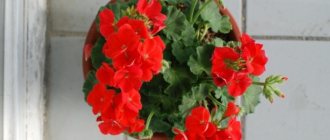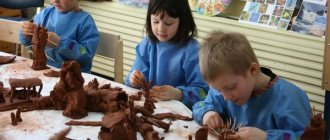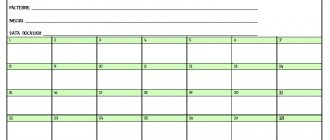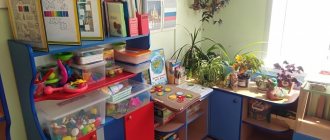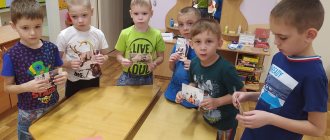Techniques for working with scissors in different age groups. Cutting methods.
Children learn techniques for working with scissors by imitating the ways of an adult. Therefore, the teacher must show the correct ways to use scissors, taking into account the difficulties that children usually experience. For example, the teacher needs to make sure that the child does not bring forward the elbow of the hand with scissors, control the movements of both hands, knowing that large parts are cut out with wide open scissors, and small parts are cut out with small, careful movements.
Let's take a closer look at the basic cutting techniques
, based on the principle of gradual increase in image difficulty for children of different age groups:
a) cutting out geometric figures and objects, the basis of which are these figures and their combinations;
b) symmetrical cutting of objects and pattern elements;
c) cutting out by eye the complex outline of objects with an asymmetrical structure.
Figure 1 shows cutting out different geometric shapes by eye
,
the technique of folding
from various types of blanks, as well as
techniques for replicating figures
(techniques for replicating geometric shapes by bending blanks into several parts are used in classes with children of only senior preschool age 6 - 7 years old) for patterned compositions.
Cutting flat geometric shapes and objects of simple and complex shapes
This way you can cut out two rectangles.
, and eight. In the first case, the workpiece in the form of a strip is divided in half over the eye, and then a straight transverse section is made (Fig. 1, 1). In the second example, to obtain eight rectangular strips, the workpiece is folded in half three times and cut along the folds seven times (Fig. 1, 2). This replication allows you to get several identical figures. These could be windows for a multi-storey building or a bus, flags for making a garland, etc.
Square
They are also cut from a strip, having previously calculated the ratio of width and length. For example, to obtain two figures, take a workpiece 4X8 or 3x6 cm. When it is necessary to cut out a larger number of squares, the workpiece is increased in length. Thus, four figures are obtained from a 4X16 cm strip, and twice as many are obtained from a 4X32 cm blank (Fig. 1, 3, 4).
Triangle
can be cut in different ways. The simplest technique is to cut the square in half diagonally with an oblique cut from one corner to the opposite (Fig. 1, 5). To replicate triangles, the same technique of folding a strip of paper is used, but in a different way: first, the workpiece is folded in half horizontally two or three times. Then, holding the fold with your left hand, make a diagonal incision, as in the first case (Fig. 1, 6). So, from a strip of 4X16 cm, seven triangles are immediately obtained.
For a trapezoidal
The opposite narrow sides of the strip are connected to each other and the corner is cut along an oblique line (Fig. 1, 7). A rhombus can be cut in two ways: by bending the rectangle in half lengthwise and crosswise and after bending, cutting off each corner from one end to the other (Fig. 1, or on a strip at the same distance from each other, oblique parallel cuts along the length are made by eye (Fig. 1 ,9).
A rhombus can be cut in two ways: by bending the rectangle in half lengthwise and crosswise and after bending, cutting off each corner from one end to the other (Fig. 1, or on a strip at the same distance from each other, oblique parallel cuts along the length are made by eye (Fig. 1 ,9).
To cut a polygon
(hexagon and octagon), the square is folded in half twice vertically and horizontally, then, stepping back from the center of the fold, the corner is cut off (octagon - Fig. 1.10). To depict a hexagon, the square is first folded in half and then into three more parts. After folding with an oblique cut from one end to the other, remove the corner (Fig. 1.11).
Rounded shapes
(circle, oval, ellipse) are cut out from a square, rectangle and strip, smoothly rounding all four corners (Fig. 1, 12-14).
The described techniques for cutting out geometric shapes are used both in composing geometric patterns
, and
when depicting objects of simple and complex shapes
, parts of which are close to the outlines of certain standard forms.
Attention!
If you need help writing a paper, we recommend turning to professionals. More than 70,000 authors are ready to help you right now. Free adjustments and improvements. Find out the cost of your work.
Cost calculationGuaranteesReviews
Objects of simple shape include those whose basis is a single figure, close to a square, circle, rectangle, etc., allowing for slight deviations (a ball, a watermelon, an orange, a melon, a flag).
Objects of a complex or combined form consist of combinations of several forms, reflecting the specifics of their structure, proportional relationship and spatial arrangement of parts.
From lesson to lesson, the child practices correctly displaying the rectangular, triangular, and round shapes of objects, consolidating knowledge of these features when conveying the outlines of familiar objects.
Greatest difficulty
for a child, represent
techniques for depicting a round shape
(circle, oval). Training should begin with the development of the ability to round corners in combination with the already learned techniques of straight and curved cuts. So, to depict carrots, peppers, and peas, children are given a strip of the appropriate color. One end of such a blank is sharpened with two oblique lines at the top and bottom. And the other end is rounded. Additionally, cut out the tops and cuttings from green paper. Leaves, petals of chamomile, marigold, dahlia, dragonfly wings, and birds are cut out in a similar way. Then the children are taught to sequentially round both ends of the workpiece when cutting out an elongated oval (cucumber, eggplant, pyramid rings), and then a short oval (melon, plum, lemon, “golden” egg) and a circle (ball, watermelon, ball, bun, beads and etc.).
Having mastered the ability to cut out geometric shapes, children learn to depict the signs of a real shape
(apple, pear, strawberry, banana, zucchini, etc.). The outlines of each of these objects have individual characteristics that differ from the geometric standard. For example, although an apple is basically round, it is still not completely identical with a circle. If a circle is a perfect curve, then in the contour of an apple such perfection is interrupted by opposing grooves, which seem to squeeze the circle from above and below or pull it vertically, forming small depressions. Therefore, to reflect these specific features in the application, it is necessary to select a blank.
To cut a round apple
with notches, take
a square
, and to display varieties with
an elongated or compressed shape,
you need
a rectangle
in a vertical or horizontal position. They also differ in color - from different shades of yellow, green, red to a complex combination - with veins - red with yellow or green with red.
For cutting lemon and pear
they also take
a rectangle
, from which an object with its characteristic shape is obtained by smoothly transitioning from a wider part to a narrow one (pear) or rounding and slightly sharpening the opposite sides (lemon). Additional stickers of leaves and cuttings increase the similarity of the applications with the original natural images (Fig. 2).
This structure of teaching how to depict objects helps the child to look more closely and remember both general and specific signs of real forms.
Most objects in the surrounding world have a complex shape
. Their structure combines rectangular, round, oblique elements in different interactions.
Such objects include houses of various types and structures (rural, multi-storey residential, public and industrial purposes, Palaces of Culture, theaters, utility buildings, etc.), means of transportation (urban passenger transport, trucks and cars, air, railway, water transport), plants, birds, labor and household items.
Many of them can be depicted in applications, so the teacher must know how to cut them out. When choosing any subject for an image, you should proceed from the following requirements
: objects must have
a clear division
, a pronounced shape, color, and the color should help highlight one or another part. The parts should be evenly spaced according to the design of the item.
Encourage children to cut out difficult objects
it is necessary
gradually
, as their structure becomes more complex - from the image of two or three homogeneous parts (snowman) to a combination of several parts of different configurations (fungus, house, beetle), and then a more complex structure (multi-story building, bus, flower).
Cutting out objects of complex shapes occurs in parts
, which requires a developed ability to divide an object into its component parts, determine their shape, ratio in size, location, color. These properties are learned and consolidated in the process of examining objects.
From individual parts, preschoolers make appliqués of different types of transport (truck, bus, tram, motor ship) depicting their design, shape and size of parts, and characteristic details. For example, based on the ability to cut and paste a bus from separate parts, children can independently perform other types of it: a minibus, an ambulance. Here it is necessary to modify some parts and include new ones: taxi checkers, light signal and red cross of ambulance, etc.
By combining different shapes, applications with images of insects, birds, and animals are created.
Symmetrical cutting
The program for children of the sixth and seventh year of life provides for mastering the ability to create appliqués using symmetrical cutting techniques
.
This technique is based on preliminary folding a piece of paper in half
or
several times
to simultaneously transfer the repeating parts of the cut out object.
This process helps to display in the application the correct structure of flowers, leaves, butterflies, some species of animals, the relationship of parts of the human figure, the uniform arrangement of decorative elements, taking into account their size and color.
In children's applications, the most striking shapes are leaves, flowers, butterflies and other objects.
.
The simplest
are used for transfer in the applique
.
Most of them are built on the principle of mirror symmetry.
Despite the variety of shapes of
the leaf plate (simple, simple dissected, complex), differences in length, relative size, structure of the edges (serrated, entire, deeply dissected), and color,
all of them
(except for unequal-sided ones)
are characterized by a general distribution of lateral sides evenly on the right and left .
Therefore, when cutting leaves, it is advisable to use the technique of preliminary folding the blanks in half
(to convey the mirror correspondence of the sides in the applique) and
simultaneous cutting through both layers of paper along the imaginary contour of half the figure relative to the fold
. Changing the shape of the workpiece, its ratio of width and length, size and color allows you to depict the variety and multicolor of leaves, especially autumn ones.
When cutting leaves by bending the workpiece in half, you should take into account the features
structure of the original figure, the relationship between its size and shape.
Square paper
is needed to depict
heart-shaped leaves
(lilac, watercolor).
Long strips
are needed when cutting out
linear shapes
, such as narcissus, amaryllis, and iris leaves.
Ovoid leaves
are obtained from
a rectangular blank
, in which
the ratio
of width to length does not differ sharply (for example, 6x4 cm).
Many leaves have a vertical extension
.
Therefore, when cutting, the workpiece is folded in half vertically
.
Only kidney-shaped leaves
(geranium, forest violet) are created from
a rectangular blank by folding it in half horizontally.
Features of the selection of blanks depending on the shape and length of the leaves, as well as techniques for cutting them after folding the paper in half are presented in Fig. 3.
By repeating the same image along the fold, it is necessary to consistently complicate the outlines of the figures.
Therefore, first you need to teach cutting out simple leaves (poplar, lilac, apple tree), and then move on to the transfer of dissected and cut or composite compositions (rowan, oxalis, strawberry, maple).
Reinforcing the techniques of folding and cutting out uniform leaves is facilitated by tasks related to the need to depict several repeating parts (a poplar branch, an autumn bouquet of leaves, a garland).
Flowers
with one axis of symmetry have different outlines
, and in each case, when cutting out, it is necessary to highlight, first of all,
the features of the form
. For example, a bell or lily of the valley has a rounded calyx at the base, and sharp petals smoothly and evenly diverge in opposite directions from the middle petal. In lily and amaryllis, the flowers are made up of gracefully curved petals scattered to the sides, while in hyacinth and iris they are rounded, curling like curls. When examining them, it is important to determine the specifics of the shape and location of the main elements in order to preserve the general but characteristic features of the flower when cutting it out of paper.
To cut flowers from paper, you can use the technique described above of folding the workpiece in half
to display in the application the equality of opposite parts of a symmetrical figure. After folding the paper, cut out half of the flower shape. At the same time, changing the outline, color and size of the paper blank allows you to obtain different images of bells, lilies of the valley, irises, lilies, gloxinia, etc.
In Fig. 4 shows techniques for cutting flowers with mirror symmetry
.
Three groups of shapes
are identified here , united by the common configuration of the workpiece (square, rectangle) and folding techniques (in one case, vertical bending is used, and in the other, diagonal).
The use of these techniques makes it possible to reflect the roundness of figures and a more correct ratio of width and length in them. So, to lengthen shapes, for example, to cut out oval-shaped plants (crocuses, irises), it is better to take rectangular paper. And for flowers with petals scattered to the sides (lilies, amaryllis, gloxinia), a square divided in half diagonally is more suitable. This technique helps to increase the image area and reflect the specificity of flowers with deeply dissected petals.
A large group of flowers with different numbers of petals is built according to the principle of axial, or central-radial, symmetry
, when the petals are evenly repeated from the middle around the circumference. Such a corolla can have three, four, five, six or more petals.
Depending on the number of these petals, the flowers are roughly grouped into different groups based on folding a blank square in a certain sequence. Thus, the second group includes four-petaled flowers, the third - eight-petaled forms (this is how daisies, daisies, etc. can be depicted). The fourth group consists of three-petaled flowers, the fifth - flowers with six petals, and the last, sixth group - five-petaled flowers.
All these flowers are cut out from a square blank
, into which shapes with parts evenly distributed from the middle to the edges fit well.
Quadripetals
cut out after bending the square in half three times: along, then across, and then diagonally (Fig. 6). This way you can cut jasmine, meadow heart, hydrangea, celandine, radish flowers, etc.
In order to convey the specific features of these flowers in the application, children must highlight and know these features before completing the task. In the process of examining flowers, the children's attention is fixed on the signs of commonality in the number of petals. For example, the meadow core has white and pink flowers with pointed petals, while hydrangea has wide ones with rounded ends, and jasmine has a beautiful notch. Wild radish has blunt petals, as if cut off (Fig. 6, 1, 2, 3).
Flowers with many petals, symmetrically located relative to the center, are conventionally presented in applications as eight-petaled forms (daisies, chrysanthemums, daisies, marigolds, cosmos, etc.).
Options for the structure of the petals, features of cutting out eight-petals
by folding the square are given in Fig. 6, 4, 5, 6.
From a piece of paper divided by folding into twelve equal parts
, you can also cut out various
shapes of snowflakes.
After folding a white square, free combinations of notches, triangles, and semicircles are cut out on the edges of the workpiece. The resulting forms are pasted onto a dark background (black, blue, purple). The contrasting color comparison of the base and the cut-outs helps convey the delicacy of the snowflakes and highlight the uniform alternation of repeating parts. Several such samples are shown in Fig. 8.
In the process of cutting out snowflakes, children's attention is directed to an independent search for various compositions for constructing figures. The teacher encourages the most interesting, creative work.
Silhouette cutting
The most difficult technique for creating appliqués for preschoolers is the technique of cutting out objects of an asymmetrical structure with curved contours by eye.
(fish, birds, animals, etc.) with complex outlines of figures, smooth transitions from one part to another.
Specifics of cutting by eye
consists in the fact that an image from paper or other materials is produced
by a continuous continuous movement of scissors along a mentally created silhouette of an object
.
Therefore, this technique is called silhouette cutting
.
The methodology for teaching preschool children silhouette cutting in appliqué was developed in detail by I. L. Gusarova. The author recommends building training on the basis of a thorough analysis of the structure of figures, highlighting the relationship of their parts, as well as by showing depiction techniques in interaction with precise verbal descriptions of each movement made with scissors
.
The process of mastering cutting by eye presents certain difficulties
. Children should have a sufficiently highly developed visual acuity and manual skill, which helps to achieve accuracy and expressiveness of the contour, and therefore show the beauty and clarity of the silhouette.
In older preschool age, perception is more meaningful, which allows the child to distinguish an object and its outlines from the surrounding world. At the same time, the word helps to analyze each shape and each movement made by the hands during the cutting process.
The teacher should approach teaching children silhouette cutting carefully. It is necessary to ensure a gradual complication of tasks by varying silhouette outlines and moving from depicting forms that are simple in configuration to more complex ones.
This situation can be seen in the example of teaching preschoolers to cut out silhouettes of dishes with an asymmetrical arrangement of parts (handles, spouts), as well as fish, birds, and animals. When selecting them, one should take into account the simplicity of the outline and the possibility of using decorative elements. Various shapes of dishes are cut out with a smooth transition from the body to the image of the spout, on the one hand, and the handle, on the other (milk jug, coffee pot, teapot).
Initially, it is necessary to determine the location and proportional relationship of the parts in shape, size, and combine rectilinear and curvilinear sections and corresponding silhouettes when cutting (Fig. 15).
Having learned to depict simple-shaped dishes (glasses, cups with handles), children can cut out more complex silhouettes (teapot, kumanets, coffee pot). They are pasted onto a colored background and decorated decoratively with paint or appliqué. This is how the relationship between classes in appliqué and decorative drawing is established, dividing the content of the work evenly into two classes. On one of them (based on applique), children learn to cut out silhouettes of dishes, and on the other, how to decorate them with patterns.
When cutting out silhouettes of dishes and other asymmetrical objects, it is important to teach the child a certain image sequence. At first
you need
to choose the shape of the workpiece
so that the object and its parts fit completely into the space of the paper in width and height.
Then
you should
determine the location and mark the parts
. This creates visual supports for a more correct rendering of the silhouette.
Silhouettes of fish, birds, and animals are cut out using the same principle.
etc. When choosing blanks for them, you should visually correlate the location of the parts, highlight the horizontal or vertical extent of the figure. For example, fish are cut out of a rectangle - strips. It is so easy to convey the sequential arrangement and connection of the main elements. The color and size of the blanks vary depending on the types of fish and the nature of their interpretation (like a folk toy, or a fairy-tale image, or natural varieties). If children cut out aquarium fish with a highly developed tail and fins, then the shape of the paper from which the children cut them out changes accordingly.
The size and shape of paper for depicting birds and animals is also taken taking into account the type and pose,
necessary for transfer to the application. So, a swan is cut out of a rectangle with an aspect ratio of approximately 8x10 or 6x8 cm. And for a giraffe, a rectangle is taken in a vertical position with an aspect ratio of 1:2. This blank helps children convey the vertical position of the main part, based on the length of the neck and other parts of the body.
We will help you write any paper on a similar topic.
- Essay
Techniques for working with scissors in different age groups. Cutting methods.
From 250 rub.
- Test
Techniques for working with scissors in different age groups. Cutting methods.
From 250 rub.
- Course work
Techniques for working with scissors in different age groups. Cutting methods.
From 700 rub.
Receive completed work or specialist advice on your educational project
Find out the cost
Learning to cut with scissors using templates
Learning to cut with scissors: the very first and simplest tasks for children. You can print out the cutting templates or replicate them by drawing similar shapes yourself.
Cutting templates “Airplanes”
The simplest tasks for learning how to cut.
Farm
Cuttings "Ladybugs"
Don’t forget the main principle when learning any new skill for a child: we move from simple to complex. These simple templates are perfect for your first cutting lessons.
Cuttings "Frogs"
Cuttings “Fruit trees”
We learn to cut with scissors, glue and recognize various geometric shapes.
Spiral template
A very beautiful and effective cutting template for children.
Cuttings "Patches"
Quest "Farmhouse"
Interesting templates - full-fledged fakes for cutting, coloring and gluing.
- Color the template details.
- Cut out the shapes at the dots.
- Glue the shapes onto the sheet, matching the corresponding numbers.
creative clippings
If difficulties may arise with ordinary cutting tasks, then cuttings “with meaning” - in fact, role-playing games - will appeal to every child.
We offer a game of being a hairdresser or manicurist!
